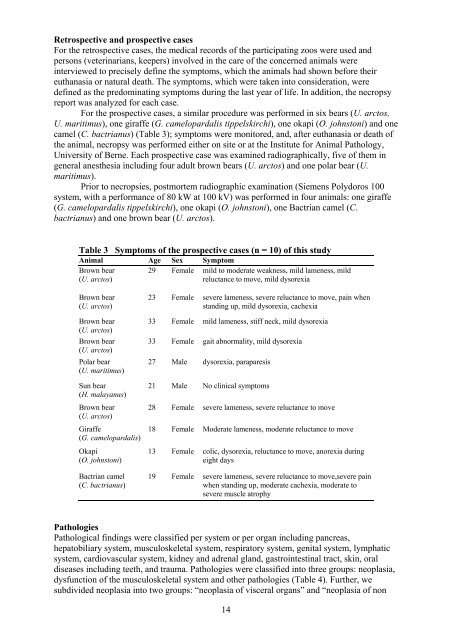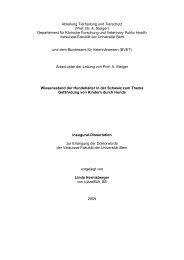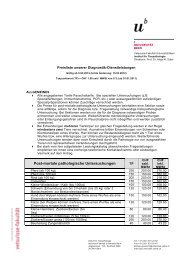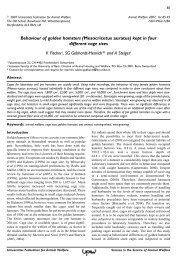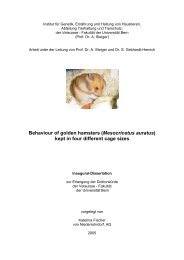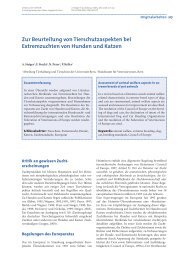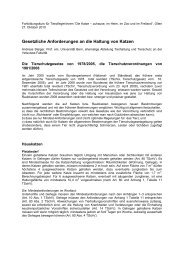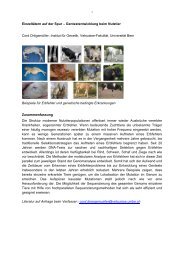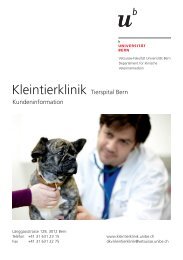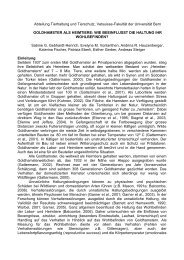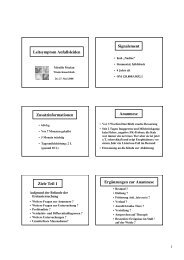Radiographic findings in several joints of nine bears
Radiographic findings in several joints of nine bears
Radiographic findings in several joints of nine bears
Create successful ePaper yourself
Turn your PDF publications into a flip-book with our unique Google optimized e-Paper software.
Retrospective and prospective cases<br />
For the retrospective cases, the medical records <strong>of</strong> the participat<strong>in</strong>g zoos were used and<br />
persons (veter<strong>in</strong>arians, keepers) <strong>in</strong>volved <strong>in</strong> the care <strong>of</strong> the concerned animals were<br />
<strong>in</strong>terviewed to precisely def<strong>in</strong>e the symptoms, which the animals had shown before their<br />
euthanasia or natural death. The symptoms, which were taken <strong>in</strong>to consideration, were<br />
def<strong>in</strong>ed as the predom<strong>in</strong>at<strong>in</strong>g symptoms dur<strong>in</strong>g the last year <strong>of</strong> life. In addition, the necropsy<br />
report was analyzed for each case.<br />
For the prospective cases, a similar procedure was performed <strong>in</strong> six <strong>bears</strong> (U. arctos,<br />
U. maritimus), one giraffe (G. camelopardalis tippelskirchi), one okapi (O. johnstoni) and one<br />
camel (C. bactrianus) (Table 3); symptoms were monitored, and, after euthanasia or death <strong>of</strong><br />
the animal, necropsy was performed either on site or at the Institute for Animal Pathology,<br />
University <strong>of</strong> Berne. Each prospective case was exam<strong>in</strong>ed radiographically, five <strong>of</strong> them <strong>in</strong><br />
general anesthesia <strong>in</strong>clud<strong>in</strong>g four adult brown <strong>bears</strong> (U. arctos) and one polar bear (U.<br />
maritimus).<br />
Prior to necropsies, postmortem radiographic exam<strong>in</strong>ation (Siemens Polydoros 100<br />
system, with a performance <strong>of</strong> 80 kW at 100 kV) was performed <strong>in</strong> four animals: one giraffe<br />
(G. camelopardalis tippelskirchi), one okapi (O. johnstoni), one Bactrian camel (C.<br />
bactrianus) and one brown bear (U. arctos).<br />
Table 3 Symptoms <strong>of</strong> the prospective cases (n = 10) <strong>of</strong> this study<br />
Animal Age Sex Symptom<br />
Brown bear 29 Female mild to moderate weakness, mild lameness, mild<br />
(U. arctos)<br />
reluctance to move, mild dysorexia<br />
Brown bear<br />
(U. arctos)<br />
Brown bear<br />
(U. arctos)<br />
Brown bear<br />
(U. arctos)<br />
Polar bear<br />
(U. maritimus)<br />
Sun bear<br />
(H. malayanus)<br />
Brown bear<br />
(U. arctos)<br />
Giraffe<br />
(G. camelopardalis)<br />
Okapi<br />
(O. johnstoni)<br />
Bactrian camel<br />
(C. bactrianus)<br />
23 Female severe lameness, severe reluctance to move, pa<strong>in</strong> when<br />
stand<strong>in</strong>g up, mild dysorexia, cachexia<br />
33 Female mild lameness, stiff neck, mild dysorexia<br />
33 Female gait abnormality, mild dysorexia<br />
27 Male dysorexia, paraparesis<br />
21 Male No cl<strong>in</strong>ical symptoms<br />
28 Female severe lameness, severe reluctance to move<br />
18 Female Moderate lameness, moderate reluctance to move<br />
13 Female colic, dysorexia, reluctance to move, anorexia dur<strong>in</strong>g<br />
eight days<br />
19 Female severe lameness, severe reluctance to move,severe pa<strong>in</strong><br />
when stand<strong>in</strong>g up, moderate cachexia, moderate to<br />
severe muscle atrophy<br />
Pathologies<br />
Pathological <strong>f<strong>in</strong>d<strong>in</strong>gs</strong> were classified per system or per organ <strong>in</strong>clud<strong>in</strong>g pancreas,<br />
hepatobiliary system, musculoskeletal system, respiratory system, genital system, lymphatic<br />
system, cardiovascular system, kidney and adrenal gland, gastro<strong>in</strong>test<strong>in</strong>al tract, sk<strong>in</strong>, oral<br />
diseases <strong>in</strong>clud<strong>in</strong>g teeth, and trauma. Pathologies were classified <strong>in</strong>to three groups: neoplasia,<br />
dysfunction <strong>of</strong> the musculoskeletal system and other pathologies (Table 4). Further, we<br />
subdivided neoplasia <strong>in</strong>to two groups: “neoplasia <strong>of</strong> visceral organs” and “neoplasia <strong>of</strong> non<br />
14


